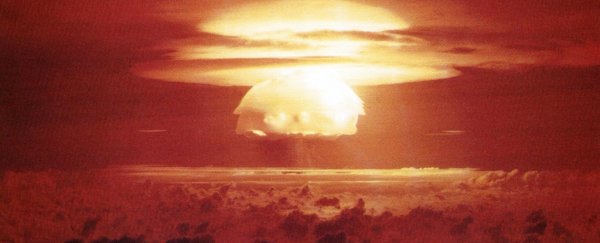Global nuclear war has been the backdrop to dozens of video games, TV shows and movies – and, unfortunately, real-life tragedies too. But if World War III really did break out and mass deployment of nuclear weapons was imminent, could anyone survive?
In the video above, Vsauce3 tackles the question of just how long you'd be able to last after a nuclear fallout, if you'd last at all.
First, though, some stats just to start that feeling of paranoia.
Although there's no official inventory, it's estimated that there are over 10,000 nuclear weapons in existence, and maybe as many as 15,000. Just a quarter of those would be enough to wipe out the whole of North America.
Then there's the power of these nukes. In 1954 Castle Bravo, the biggest nuclear bomb ever detonated by the United States, created a mushroom cloud that rose to 40 kilometres (25 miles) within ten minutes and stretched for almost 100 kilometres (62 miles) across the ocean.
Creating an explosive yield of 15 megatons of TNT, it was similar to setting off a billion kilograms of TNT at once. What's more, the Tsar Bomba nuclear test by Russia in 1961, still the largest man-made explosion ever, was more than three times bigger than that.
We're here to discuss fallout, though: the radioactive waste from a blast that can contaminate the environment and everything that lives in it, including human beings.
Thanks to the mushroom cloud from a nuclear blast and the prevailing winds of the moment, radioactive particles can travel thousands of kilometres from the original explosion point. In the case of Castle Bravo, an area more than 12,950 square kilometres (5,000 square miles) was affected, so something about a third the size of Switzerland, then.
And all this radioactive material isn't necessarily easy to spot. Take Strontium-90, which contaminates soil, plants, and then the animals that feed on them. Once it gets in our bones, it can keep emitting radiation for years, causing bone cancers and leukaemia.
Ultimately it's a question of getting as far away from the initial blast, and the area covered by radioactive waste, as you possibly can. Even then, you could be in for a pretty grim time of it, if the society around you starts collapsing (check out The Road if you're not sure what we mean).
Initially, the keys to staying alive are time, distance, and shelter, as this video from the American Chemical Society shows: exposure to radioactivity for the least time possible, as much distance from the main blast as possible, and as much shelter from the contaminated environment as possible.
After that your survival skills come into play – can you find and farm food? Can you find water? Even the most well-stocked nuclear fallout shelter won't last forever.
Let's just hope we never have to put ourselves to the test, and that this famous quote from Albert Einstein is never fulfilled: "I know not with what weapons World War III will be fought," he said, "but World War IV will be fought with sticks and stones."
